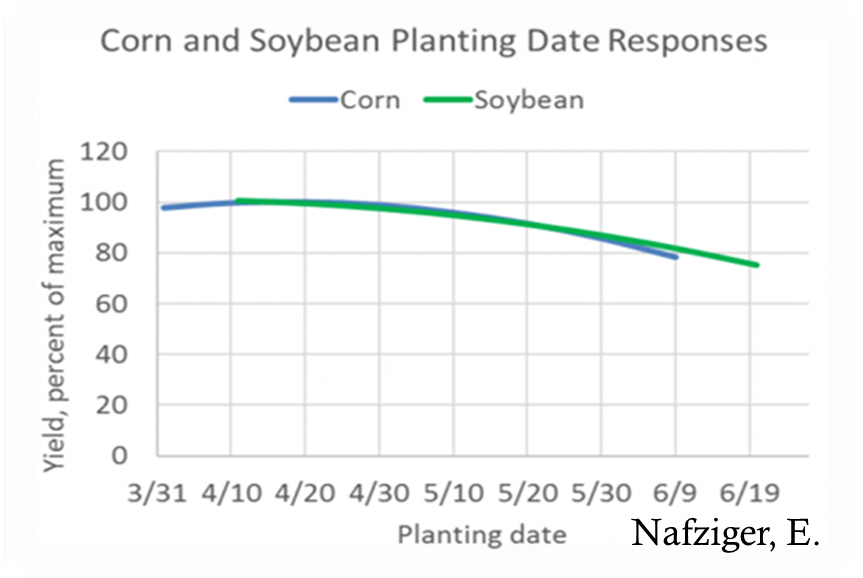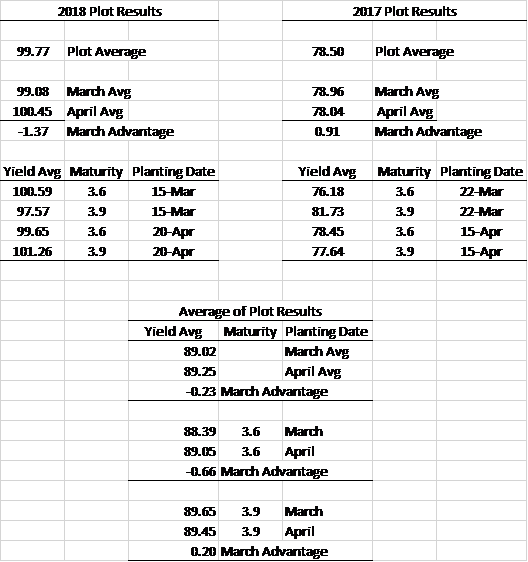There has been a lot of buzz lately in the soybean world about planting soybeans super early. Is this method of planting soybeans early all hype or is there an actual yield ‘bump’ behind the madness?
As farmers continue to push the planting date on soybeans, little research has been done on planting soybeans in March. In pursuit of my master’s degree from Iowa State University, I have chosen to study the planting of soybeans in March. This research project is designed to help identify if there is a yield increase over April-planted soybeans. Currently, the University of Illinois at Urbana-Champaign (UIUC) has shown that the mid-April timeframe is the best time to plant to capture 100% yield potential. However, the planting date study starts on April 10. I’m curious about happens before that, does the trend-line continue to go up?
In pursuit of my master’s degree from Iowa State University, I have chosen to study the planting of soybeans in March. This research project is designed to help identify if there is a yield increase over April-planted soybeans. Currently, the University of Illinois at Urbana-Champaign (UIUC) has shown that the mid-April timeframe is the best time to plant to capture 100% yield potential. However, the planting date study starts on April 10. I’m curious about happens before that, does the trend-line continue to go up?
There is a lot to consider when planting soybeans in March. For example, the planting window in March is normally extremely small. This is generally due to lack of heat that seen during this time and as a results little to no drying will occur from previous rainfall events. During my 2018 trial, I only had 1 day to plant soybeans (March 15). And during my 2017 trial, I only had 2 suitable days for planting. For this trial I did not care about soil temperature at planting, but soil conditions had to be dry to avoid any compaction.
When planting in soybeans in March it will generally be cold, not only at planting but also afterwards and as a result emergence will be the biggest hurdle to overcome. In my experience, soybeans planted in March will take about 30 days to emerge. This is due to the lack of growing degree units (GDUs) that are often seen in March and early April. I have done this trial for 2 years and both times a soil crust formed which could have caused poor emergence. Once a crust forms on the surface, a rotary hoe or a rainfall event must occur at the correct time to assistance with emergence. For both years I used a rotary hoe to aid in emergence and to ensure populations where in the optimum range.
In this year’s trial the soybeans took 45 days to emerge, 2017 took 31 days. Unbelievable! Since emergence took over 30 days to occur the seed treatment had lost its’ effectiveness which resulted in a stand reduction, but not enough to warrant a replant. Generally seed treatments lose effectiveness after 30 days due to the breakdown of the treatment. This was seen accross both years of the trial where initial populations were very good at emergence but steadily declined due to seedling diseases and cool soil temperatures.
The one benefit from planting soybeans in March is the possibility of planting later maturing soybean groups. Overall, I saw a weak advantage to soybeans planted in March compared to ones that were planting in April. Generally, the March soybeans maturated around September 10 and the April soybeans matured a week later, this was witnessed in both years of the study. With this relatively early maturing of the soybeans one could consider planting later maturing soybean groups to take more advantage of the growing season and possibly gain more yield.
From the research I have conducted for the last two years I would confidently say leave your soybeans in the bag until mid-April, for central Illinois. From what I have seen there was a slight advantage in 2017 for planting soybeans in March – 0.91 of a bushel. Compared against 2018 where the April soybeans had a 1.37-bushel advantage over the March beans. When we compare both years we can see that there is no significance yield difference between the two planting dates. Due to the risk associated with planting soybeans in March, I’d wager it’s a smarter decision to wait until April.



 and then
and then